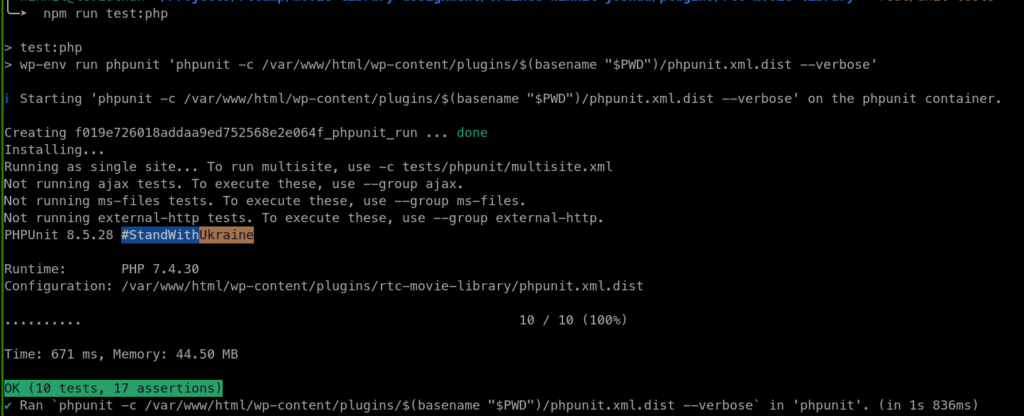Setting up for WP Unit Tests with NPM & WP-ENV
In this lesson we’ll learn how to set up WP PHPUnit testing using wp-env which doesn’t require additional Test DB setup. This will help you understand what is happening under the hood.
For standard / typical setup guide please follow:
We will use the following tools:
- Composer
- NPM
- Docker (Internally)
Let’s get started.
The following code is the minimum files / code required to run the WP PHP Unit tests.
Note: For this setup we don’t have to download the wordpress-develop repo.
Composer setup
- Step 1
- Create composer.json file
- Add in basic details
- Step 2
- Add classmap autoload for your plugin src files
- Add classmap autoload-dev for your test directory files.
| { “name”: “namespace/plugin-name”, “require-dev”: { “phpunit/phpunit”: “^8.5”, “wp-phpunit/wp-phpunit”: “^5.9”, “yoast/phpunit-polyfills”: “^1.0” }, “autoload”: { “classmap”: [ “inc/” ] }, “autoload-dev”: { “classmap”: [ “tests/” ] } } |
NPM Setup
The only dependency is @wordpress/env
Create following script commands
| “test:php”: “wp-env run phpunit ‘phpunit -c /var/www/html/wp-content/plugins/$(basename \”$PWD\”)/phpunit.xml.dist –verbose'”, “wp-env”: “wp-env” |
Note:
- “wp-env run” is for starting / stopping the environment.
- test:php for running phpunit tests
- $(basename \\”$PWD\\”) might not work on Windows, you can use Git Bash to make it work on Windows
| { “name”: “plugin”, “scripts”: { “test:php”: “wp-env run phpunit ‘phpunit -c /var/www/html/wp-content/plugins/$(basename \”$PWD\”)/phpunit.xml.dist –verbose'”, “wp-env”: “wp-env” }, “devDependencies”: { “@wordpress/env”: “^4.9.0” } } |
Configure wp-env
In plugin’s root folder create .wp-env.json file, add the following code.
You can change the ports according to your system’s availability of ports
| { “core”: null, “phpVersion”: “7.4”, “plugins”: [“.”], “themes”: [“../../themes/yourthemedirectory/”], “port”: 5888, “env”: { “tests”: { “port”: 5889 } } } |
For further details about wp-env config please visit:
https://www.npmjs.com/package/@wordpress/env
Bootstrap file
We need to define a bootstrap file which loads the required files and functions
- Create tests/php/unit directory
- Create bootstrap.php in tests/php directory
- Add the follow code.
| <?php /** * PHPUnit bootstrap file * * @package features-plugin-v2 */ define( ‘TESTS_PLUGIN_DIR’, dirname( __FILE__, 2 ) ); define( ‘WP_TESTS_PHPUNIT_POLYFILLS_PATH’, dirname( TESTS_PLUGIN_DIR ) . ‘/vendor/yoast/phpunit-polyfills’ ); // Determine correct location for plugins directory to use. define( ‘WP_PLUGIN_DIR’, dirname( dirname( TESTS_PLUGIN_DIR ) ) ); define( ‘WP_PHPUNIT__DIR’, dirname( TESTS_PLUGIN_DIR ) . ‘/vendor/wp-phpunit/wp-phpunit/’ ); // Load Composer dependencies if applicable. if ( file_exists( dirname( TESTS_PLUGIN_DIR ) . ‘/vendor/autoload.php’ ) ) { require_once dirname( TESTS_PLUGIN_DIR ) . ‘/vendor/autoload.php’; } // Detect where to load the WordPress tests environment from. $_test_root = WP_PHPUNIT__DIR; require_once $_test_root . ‘/includes/functions.php’; /** * Load plugin in test env. * * @return void */ function features_plugin_unit_test_load_plugin_file() { require_once dirname( TESTS_PLUGIN_DIR ) . ‘/you-plugin-init-file.php’; } tests_add_filter( ‘muplugins_loaded’, ‘features_plugin_unit_test_load_plugin_file’ ); require $_test_root . ‘/includes/bootstrap.php’; |
Configure tests using phpunit.xml.dist
In the plugin’s root directory create phpunit.xml.dist and add the following configuration:
| <phpunit bootstrap=”tests/php/bootstrap.php” backupGlobals=”false” colors=”true” convertErrorsToExceptions=”true” convertNoticesToExceptions=”true” convertWarningsToExceptions=”true” > <testsuites> <testsuite name=”unittest”> <directory suffix=”-test.php”>./tests/php/unit</directory> </testsuite> </testsuites> </phpunit> |
Note:
For Mac users, you need to add the below <php> tag element inside <phpunit> to run.
| <php> <env name=”WP_PHPUNIT__TESTS_CONFIG” value=”/wordpress-phpunit/wp-tests-config.php”/> </php> </phpunit> |
Running the tests
After adding all the files, it’s time to run the tests. You can add tests code in ./tests/php/unit folder.
The file structure / hierarchy can reflect your plugin’s source structure / hierarchy with *-test.php appended.
To start running tests:
- Step 1: Start wp-env by using npm run wp-env start
- This will create all the docker containers required
- Step 2: Run npm run test:php
- This will run all the tests which are in the tests/php/unit folder and that’s it. Your WP PHPUnit testing setup is ready to roll.
Output:
